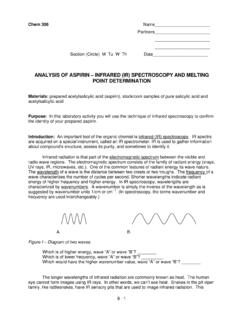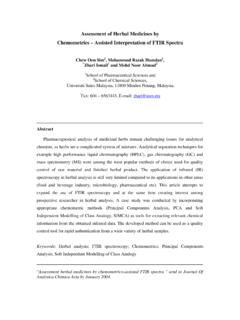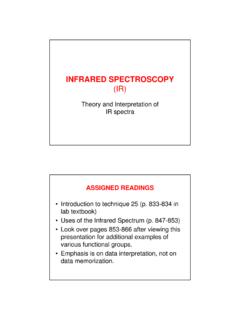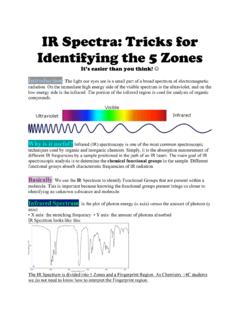Transcription of The Fundamentals of Infrared Spectroscopy - Midac
1 Fundamentals of Infrared Spectroscopy Midac Corporation 1 TN-100 The Fundamentals of Infrared Spectroscopy Joe Van Gompel, PhD The Principles of Infrared Spectroscopy Spectroscopy is the study of the interaction of electromagnetic radiation with matter. The electromagnetic radiation may be anywhere from very high energy gamma rays to low-frequency radio waves. The nature of the interaction depends upon the frequency or energy of the electromagnetic radiation and also on the properties of the matter. The interactions may be ionizing (gamma- and x-rays), chemical-electronic (UV-visible), vibrational / rotational ( Infrared ), or magnetic (microwave or lower). There are many aspects to Spectroscopy and it is not in the scope of this note to consider all of these.
2 The electromagnetic spectrum covers a wide range of wavelengths. The Infrared regions are classified as follows: Near Infrared 12,500 to 4,000 cm-1 ( to m) Mid Infrared 4,500 to 400 cm-1 ( to 50 m) Far Infrared 400 to cm-1 (50 to 800 m) Using these units, visible light is from to m, or 27,778 to 13,333 cm-1. There is a discussion of these units below. In the case of Infrared Spectroscopy , Infrared light passes through a sample and certain frequencies of the light are absorbed by the chemical bonds of the substance, leading to molecular vibrations. The Infrared region considered in this note is the mid- Infrared , from 4500cm-1 to 400 cm-1. The frequencies and intensities of absorbed Infrared light depend on the specific bond strengths and atoms of that molecule, and the absorption pattern (called a spectrum) is unique for each material.
3 The condition of the material, such as the temperature, the state (solid, liquid, or gas), concentration, pressure, and other materials in a mixture also affect the spectrum. It is this spectrum that makes Infrared Spectroscopy a very powerful tool for both qualitative and quantitative analysis. Spectroscopy instrumentation, in simplest terms, involves a light or emission source, optics, a sample holder, and a detector. The optics are used to direct the light from the source through the sample and on to the detector. The optics are also used to condition the light in such a way that the light collected from the detector can be interpreted. In Fundamentals of Infrared Spectroscopy Midac Corporation 2 some cases this involves breaking the light up into component wavelengths so that the sample is exposed to only a narrow region of the spectrum at any one time.
4 In this form of Infrared Spectroscopy the wavelength of light incident on the detector at a given time is known. This is called DISPERSIVE Spectroscopy because the light is dispersed into its component wavelengths. In many cases, however, the optics are more complex. In the case of Fourier Transform Infrared Spectroscopy (FTIR), the optics include an INTERFEROMETER, which modulates the Infrared light such that the sample is exposed to the entire spectrum simultaneously. The individual wavelengths are then determined using mathematical operations (specifically the Fast Fourier Transform) to interpret the modulated light. This arrangement, while more complicated, leads to great advantages in terms of collection time, resolution, and signal-to-noise ratio.
5 The mechanical and operational details of the interferometer are discussed in another applications note. The Infrared spectrum is measured by either absorbance or percent transmittance on the y-axis and by either the wavelength (um) or wavenumber (cm-1) to measure the position of an Infrared absorption on the x-axis. Most compounds have characteristic absorptions in the Infrared region. Tables of characteristic IR absorptions of functional groups can be found in most organic chemistry text books. A simple spectrum showing an idealized band is shown in Figure 1. Figure 1. An idealized absorbance band in transmittance on the y-axis. Fundamentals of Infrared Spectroscopy Midac Corporation 3 In this case, the y-axis shows transmittance, in which case the line at the top indicates all of the light at that wavelength is making it to the detector.
6 The absorption band points downward. The strength of the absorption band is often reported as a value from 0 to 100 in percent transmittance. The light at that frequency or wavelength is being absorbed, or soaked up, by the chemical bond, causing it to vibrate more. The light that is absorbed by the chemical bond does not make its way to the detector, and so the transmitted light is reduced at that frequency. The intensity of the absorption is described in Equation 1: Transmittance T = I/Io Equation 1 Io = Intensity of incident radiation from the Infrared source at that frequency I = Intensity of transmitted radiation that reaches the detector at that frequency An Infrared spectrum is often viewed in absorbance, with the peaks pointing up from the baseline instead of downward.
7 The relationship between transmittance and absorbance is logarithmic, as described in Equation 2. That is, 100% transmittance is 0 absorbance units, 10% transmittance is 1 absorbance units, 1% transmittance is 2 absorbance units, etc. Absorbance A = log(1/T) = log(Io/I) = ecL Equation 2 e = molar extinction coefficient (or molar absorptivity) c = concentration L = sample pathlength An absorption band can be characterized by two parameters; the wavelength at which maximum absorption occurs, and the intensity of absorption at this wavelength. In an absorption spectrum, the intensity of the band is proportional to the number of molecules ( the concentration) of the material being sampled.
8 Similarly, the sample pathlength term means that a longer (or thicker) sample will absorb more strongly. Both of these factors make Infrared Spectroscopy a very powerful tool for quantitative analysis. The units commonly used on the x-axis in Infrared Spectroscopy are either the wavelength in micrometers or microns, using the Greek letter mu ( ), or wavenumbers, also referred to as reciprocal centimeters (cm-1). Consider the wave properties of light. The wavelength is simply the distance between one wave maximum and the next. See Figure 2. Fundamentals of Infrared Spectroscopy Midac Corporation 4 Figure 2. Wavelengths and wavenumbers.
9 In this case, the sine wave has maxima at , , and micrometers, so the wavelength is micrometers. If this drawing were extended out to fill one entire centimeter (10,000 micrometers per cm), then there would be a total of 10,000 = of these maxima. This is the wavelength as measured in reciprocal centimeters; = cm-1. Spectroscopists use both wavelength and wavenumbers, but wavenumbers are preferred because the energy of light varies directly with wavenumber. In other words, the energy of light increases (red to blue) as the wavenumber value increases. Wavelengths were used extensively in the early days of Infrared Spectroscopy , but wavenumbers are used almost exclusively today.
10 Wavenumbers will be used exclusively in the remainder of this note. Fundamental Vibrations of Molecules As mentioned, Infrared light matches the vibrational frequencies of the molecular bonds. When Infrared light is incident on the molecule, the frequency which corresponds with the natural vibrational frequency may be absorbed by the molecule, increasing the magnitude of the natural molecular vibrations. Some bonds absorb more strongly than others, and some compounds give very complex spectra. The details governing the specifics of an absorption band can be described mathematically and are couched in quantum mechanical terms. In order for a vibration to be Infrared active , it is necessary for a change in the dipole moment to occur during the absorption of the Infrared light.










